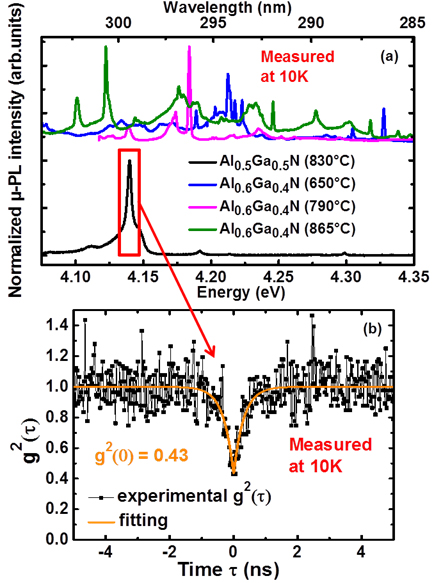Nanowires made of nitride semiconductors (GaN, AlN, InN and various ternary alloys such as AlGaN) have been studied for almost twenty years. Nitride semiconductors are quite important as they are used for white LEDs (Nobel Prize 2014) and Blu-ray technology lasers for instance, despite the fact that they are grown on hetero-substrates so that thin films made of nitride semiconductors have large dislocation densities. In particular growth conditions in plasma-assisted molecular beam epitaxy, GaN can grow as nanowires on silicon substrates. These nanowires are of very high crystalline quality, which leads to very good light emission properties. In the NanoPhysics and SemiConductors (NPSC) CEA-CNRS joint team, we have been studying the precise nucleation and growth mechanisms of such nanowires for many years, as well as their optical properties. One of the possible applications of such nanowires would be to use them as the light emission region in an ultraviolet emitting device, which is possible when using AlGaN alloys. Such a device emitting in the 260-280 nm spectral region can be used for water or air sanitization.
A first step towards this goal is to precisely understand the growth mechanism and the optical properties of such AlGaN nanowires. This is what has been done by PhD student Matthias Belloeil (funded by
labex GaNex) under the supervision of B. Daudin and B. Gayral. By growing AlGaN nanowires at various substrate temperatures and with various Al, Ga and N fluxes, and subsequently studying the nanowires he grew by structural techniques (scanning transmission electron microscopy and energy dispersive X-ray spectrometry) and optical spectroscopy (spatially-resolved photoluminescence), he could gain a better understanding of the growth mechanism as well as of the light emission properties. The study of the luminescence of single nanowires notably shows the emission of sharp lines, that we attribute to spatially localized emission. This localization of electrons and holes can happen due to very short scale fluctuations of the ternary alloy. This quantum-dot like behavior is more precisely characterized by single photon correlation spectroscopy that shows directly that in our case the AlGaN material behaves as a collection of quantum dots. This fundamental study of AlGaN nanowires is a further step towards the optimization of nanowire-based UV emitting devices. More generally, it shows that nanowires allow to study a very small volume of material by various complementary techniques (in the present case, electron microscopy and luminescence).
Ackowledgments: GaNex, PFNC

The upper graph displays the photoluminescence spectra of single AlGaN nanowires grown with various Al compositions and at various substrate temperatures. The lower graph displays the correlation function for one emission peak, which exhibits “antibunching”, a signature of single photon emission which shows that the AlGaN nanowire is made of electron localization centers which behave as quantum dots.